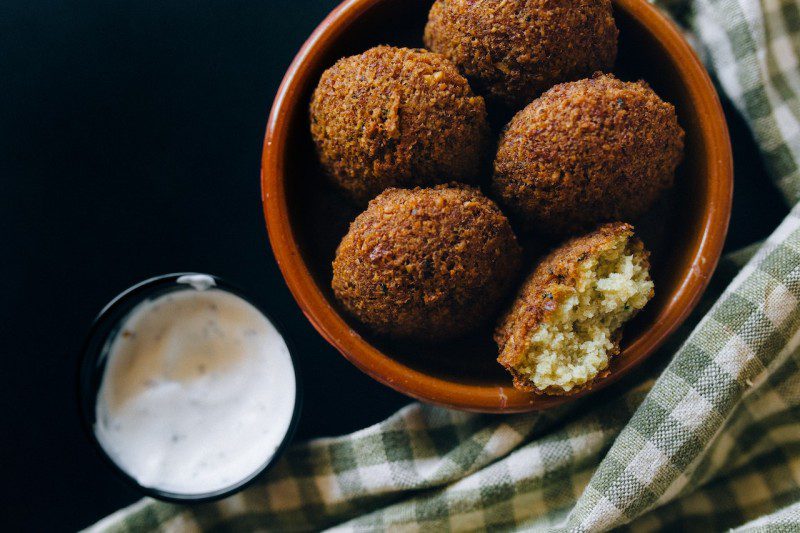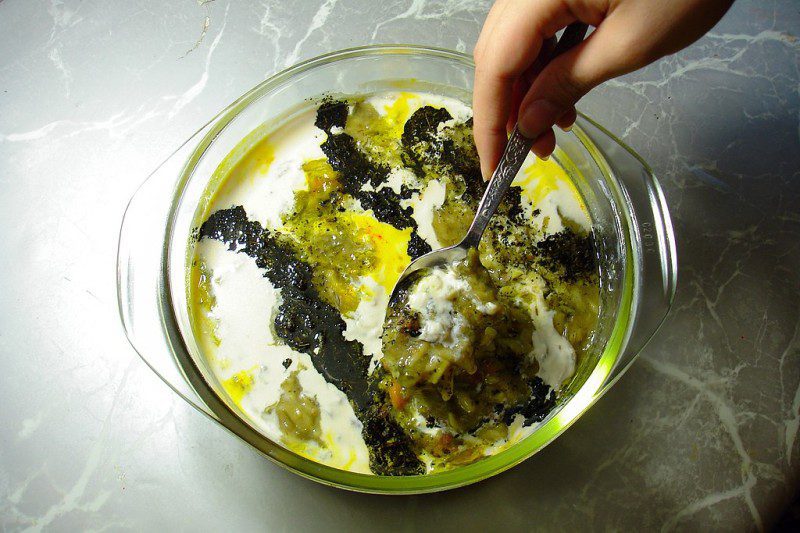Table of Contents
Iran is a country known for its vibrant street food culture. Exploring the streets of Iranian cities unveils a world of culinary delights that tantalize both the taste buds and the soul. From traditional recipes passed down through generations to contemporary creations, street food in Iran offers a diverse range of flavors that are bound to leave a lasting impression. In this article, we will delve into the most popular street foods and snacks in Iran, providing an enticing glimpse into the country’s gastronomic treasures.
1. Ash Reshteh : The most Popular Ash
Ash Reshteh is a hearty soup (But Iranians say it is not a soup!) that can be enjoyed throughout the year. This soul-warming delicacy is made with a combination of vegetables, beans, chickpeas, and noodles (Reshteh) as its base ingredients. The distinct flavor of Ash Reshteh is derived from Kashk, a white salty whey product, as well as the fried garlic, onion, and mint toppings.
Ash holds significant cultural importance in Iran, being prepared not just as a meal but also for various occasions. One such example is Ash-e Posht-e Pa, where family and friends gather to bid farewell to a loved one embarking on a journey, whether it be a pilgrimage or military service. They come together to share a meal, offering solace and expressing their hope for a swift return.
You might find Ash Reshteh in Iran’s streets during winter! Have a bowl and feel warmer during winter in Iran.
2. Falafel : A Sandwich to Test
Falafel, an all-time favorite street food in Iran, is a vegetarian delight primarily made from chickpeas. These crispy and flavorful balls or flat patties are commonly enjoyed in a sandwich format. A typical falafel sandwich consists of a bed of pickled vegetables, lettuce, cabbage, and falafel patties, accompanied by a variety of sauces. Originating from the southern regions of Iran, falafel has gained immense popularity and can be found on street corners across the country. It is worth noting that the spiciness of falafel can vary depending on the location, with southern regions offering a bolder kick.

While the traditional method involves wrapping falafel in a baguette, some local establishments opt for using traditional Iranian bread. Additionally, self-service spots provide a unique experience where customers can customize their own falafel sandwich by selecting from a range of bread, falafel, vegetables, pickles, and sauces.
3. Samboseh : Fried Bread and Potato
Another Iranian street food hailing from the south is Samboseh or Samosa. This delectable snack features a triangular Lavash bread filled with a savory mixture of cooked potato, onion, meat or chicken, and various spices. Samboseh offers a convenient option to satiate your hunger in the hours leading up to a meal.
4. Jigar : Not for Vegans
Jigar, an absolute delight for non-vegetarians, is a street food that may not appeal to everyone due to its unique ingredient: liver of sheep or cow. This delicacy involves chopping the liver into pieces, seasoning it with spices, skewering it on aluminum sticks, and grilling it over hot charcoal.
Jigar is cherished by many in Iran, with some indulging in more than three sticks. Jigaraki shops also offer other organ kebabs such as Del (heart) Kebab and Gholveh (Kidney) kebab. Interestingly, the terms Del, Gholveh, and Jigar are commonly used in colloquial Farsi to express affection among friends or to refer to adorable children. So, would you like to experience the camaraderie of a Jigaraki shop?
5. Balal – Corn on Streets
While not an item that will leave you feeling full, Balal is a delightful and healthy snack to enjoy while strolling through Iranian parks or popular city locations. As evening falls, you will often spot vendors grilling corn over charcoal and subsequently dipping it into a saltwater bucket. This process imparts a distinctive Iranian flavor to the corn, offering a memorable culinary experience. Just remember to keep a toothpick handy for afterwards!
6. Baghali : Angelica Seeds for Cold Nights
Baghali, a popular street food in Iran, becomes truly exceptional when seasoned with red sumac and angelica seeds. The combination of flavors elevates this dish to new heights. Baghali is typically sold in small bowls, and while some prefer to consume it with the peel intact, others opt to remove it. Peeling Baghali requires some skill, and those proficient at it can claim a larger portion. To enjoy this treat, peel the head or bottom of the fava bean using your front teeth, and then, while squeezing the other end with your fingers, suck the soft fleshy bean out of its peel.
8. Labou : Red Beetroot
Labou, known as beetroot in English, is a vibrant red street food that not only tantalizes the taste buds but also offers numerous health benefits. It is said that fruits and vegetables with a color reminiscent of blood are rich in iron and contribute to overall well-being. Labou serves as a comforting source of nutrition on cold winter days and is often enjoyed alongside Baghali.
9. Haleem : A Favorite Breakfast
Haleem, a delightful Iranian street food, is traditionally consumed as an early morning breakfast, although it can be found throughout the day in major cities. It has become a cherished family tradition for Iranians to gather around and savor Haleem together. This flavorful dish is made from a mixture of wheat, meat, and sometimes milk, resulting in a unique blend of textures and tastes. The addition of cinnamon enhances its aroma, creating an irresistible culinary experience that brightens your day.
10. Shawarma – A Middle Eastern Souvenir
Shawarma, a well-known Middle Eastern street food, has found its way into the Iranian culinary landscape. Similar to falafel, but with different ingredients, Shawarma consists of thinly sliced lamb meat or chicken accompanied by lettuce, carrot, basil, and occasionally mushrooms. The meat is stacked and roasted, reminiscent of the preparation method used for Turkish sandwiches. While originating from the Middle East, Shawarma has gained popularity in Iran, offering locals and visitors a taste of international flavors.
11. Adasi : A Brown Hearty Dish
Adasi, a hearty dish made from lentils, is considered a miraculous treat for those seeking warmth and sustenance. Just like hot Ash, this Iranian street food offers a comforting respite during chilly weather. Adasi is prepared with lentils, onion, potato, and a selection of spices. While it is typically enjoyed in its vegetarian form, some grandmothers prefer to add meat for added richness. Savor Adasi with a dash of lime juice and a drizzle of olive oil for an even more flavorful experience.
12. Fereni : Same as Indian Kheer
The final street food on our list is Ferni, an Iranian rendition of the Indian dessert Kheer. Made from milk, sugar, and starch or rice flour, Ferni boasts a unique flavor profile that is unparalleled. The addition of saffron, turmeric, butter, and rosewater elevates the dish, resulting in a delightful treat. Ferni is typically served without sugar, accompanied by natural berry syrup or date syrup to add a touch of sweetness to each spoonful.
In conclusion, Iran’s street food scene is a culinary adventure waiting to be explored. From the heartwarming Ash Reshteh to the crispy falafel, each street food item offers a distinct flavor and a glimpse into the country’s rich gastronomic heritage. So, the next time you find yourself wandering the streets of Iran, make sure to indulge in these mouthwatering delights and experience the vibrant tapestry of flavors that define Iranian street food.
Cultural Significance of Food in Iran’s Culture
Food plays a significant role in Iranian culture and is often a symbol of hospitality and celebration. Iranians take great pleasure in gathering around a table to share a meal, fostering a sense of community and connection. Special occasions and festivals like Nowruz, the Persian New Year, are marked by feasts that honor culinary traditions and showcase the diversity of Iranian cuisine.
How Are Iranian Foods?
Iranian foods are a delightful blend of rich flavors, fresh ingredients, and aromatic spices. The cuisine showcases a diverse range of dishes, from succulent meat kababs to hearty stews and fragrant rice specialties. Fresh herbs like parsley, mint, and dill add a vibrant touch, while spices such as saffron, turmeric, and cardamom infuse depth and complexity into the flavors. Iranian cuisine also places a strong emphasis on rice, with the art of steaming it to perfection and creating a crispy layer called Tahdig. Whether it’s savoring a flavorful stew like Ghormeh Sabzi or indulging in a delectable dessert like baklava, Iranian foods offer a truly captivating gastronomic experience.
Iranian cuisine is characterized by its rich and varied flavors, with a harmonious balance of sweet, sour, and savory tastes. Fresh ingredients, including herbs, fruits, and vegetables, contribute to the vibrant and healthy nature of the dishes. Grilled meat kababs are a favorite, showcasing the mastery of flavors and tenderness of the meat. Iranian desserts, often infused with rosewater and saffron, provide a delightful conclusion to a meal. From the fragrant rice dishes to the aromatic stews, Iranian foods are a culinary adventure that will leave your taste buds craving for more.
